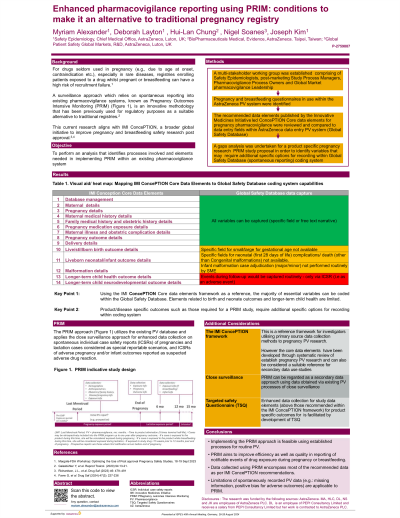Pregnancy and lactation
Session: Poster Session B
(258) Enhanced pharmacovigilance reporting using PRIM: conditions to make it an alternative to traditional pregnancy registry
Tuesday, August 27, 2024
8:00 AM - 6:00 PM CEST
Location: Convention Hall II


Myriam Alexander, PhD (she/her/hers)
Associate Director of Safety Epidemiology
Safety Epidemiologyy, Chief Medical Office, R&D, Astrazeneca, Luton, UK
Luton, United Kingdom
Presenting Author(s)
Background: For drugs seldom used in pregnancy (e.g., due to age at onset, contraindication etc.), especially in rare diseases, registries enrolling patients exposed to a drug whilst pregnant or breastfeeding can have a high risk of recruitment failure. A surveillance approach which relies on spontaneous reporting into existing pharmacovigilance systems, known as Pregnancy Outcomes Intensive Monitoring (PRIM), is an innovative methodology that has been previously used for regulatory purposes as a suitable alternative to traditional registries.
Objectives: To perform an analysis that identifies processes involved and elements needed in implementing PRIM within an existing pharmacovigilance system
Methods: A working group at AstraZeneca performed a review of the pregnancy and breastfeeding questionnaires in use in the pharmacovigilance systems and compared them with recommended fields published by the Innovative Medicines Initiative led ConcePTION Core data elements for pregnancy pharmacovigilance. Questionnaires were also aligned with objectives of the PRIM for a specific drug of interest and suitable fields were genericised to become applicable to any drug use in pregnancy or breastfeeding.
Results: Fourteen tables in ConcePTION were collapsed into a series of questionnaires (at first reported exposure during pregnancy or breastfeeding, for each pre-specified follow-up) that could be implemented for notification reports, achieving a balance between free-text and structed entry that considered the length of the questionnaire as well as rules for data entry. Processes for mapping the data entry to the routine pharmacovigilance database system, as well as for extracting data for analysis and programming are also in development.
Conclusions: Implementing the PRIM approach is feasible although it requires enhancements in the pharmacovigilance system which in turn are set to improve efficiency as well as quality in reporting of notifiable events of drug exposure during pregnancy or breastfeeding. Missing information in spontaneous reporting as well as biased reporting toward more frequent reporting of adverse clinical outcomes may be potential sources of bias to consider with a PRIM approach.
Objectives: To perform an analysis that identifies processes involved and elements needed in implementing PRIM within an existing pharmacovigilance system
Methods: A working group at AstraZeneca performed a review of the pregnancy and breastfeeding questionnaires in use in the pharmacovigilance systems and compared them with recommended fields published by the Innovative Medicines Initiative led ConcePTION Core data elements for pregnancy pharmacovigilance. Questionnaires were also aligned with objectives of the PRIM for a specific drug of interest and suitable fields were genericised to become applicable to any drug use in pregnancy or breastfeeding.
Results: Fourteen tables in ConcePTION were collapsed into a series of questionnaires (at first reported exposure during pregnancy or breastfeeding, for each pre-specified follow-up) that could be implemented for notification reports, achieving a balance between free-text and structed entry that considered the length of the questionnaire as well as rules for data entry. Processes for mapping the data entry to the routine pharmacovigilance database system, as well as for extracting data for analysis and programming are also in development.
Conclusions: Implementing the PRIM approach is feasible although it requires enhancements in the pharmacovigilance system which in turn are set to improve efficiency as well as quality in reporting of notifiable events of drug exposure during pregnancy or breastfeeding. Missing information in spontaneous reporting as well as biased reporting toward more frequent reporting of adverse clinical outcomes may be potential sources of bias to consider with a PRIM approach.
